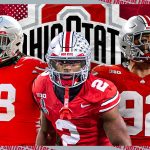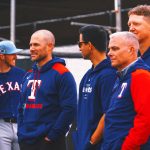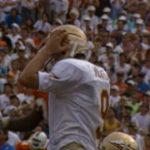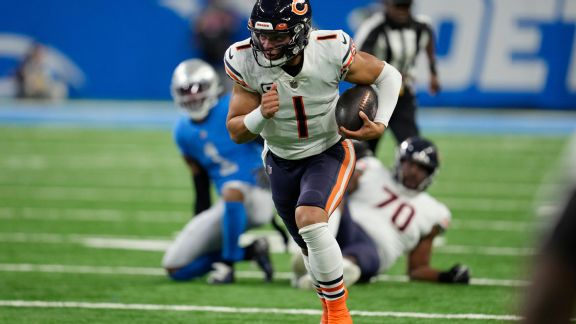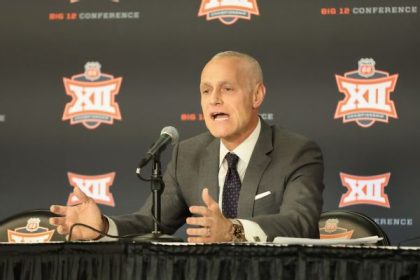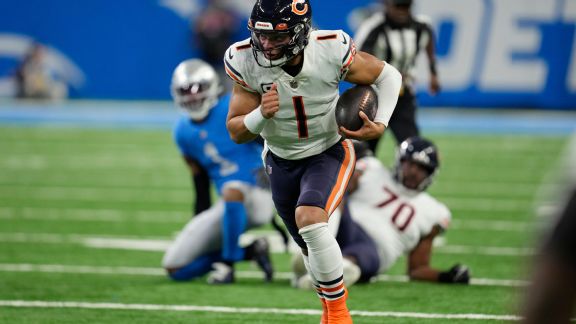
CHICAGO — Before adding players who could help the Chicago Bears take the next step toward becoming a winning franchise, general manager Ryan Poles has to evaluate players currently on the roster and determine whether they fit into his vision for 2023 and beyond.
As with every NFL team, that plan ultimately centers around the starting quarterback. Last month at his season-ending news conference, Poles expressed excitement over Justin Fields’ trajectory.
“He showed the ability to be impactful with his legs, and there’s flashes with his arm,” Poles said. “Now if we can put that together, I think we have something really good.”
Poles said he plans on Fields being the Bears’ starting quarterback in 2023, and he made it clear that despite having the No. 1 overall pick in this year’s draft, the GM would have to be “blown away” by a prospect to select a quarterback and move on from Fields.
The process of building the 2023 Bears began in earnest last week. Poles and members of his scouting department got an up-close look at draft prospects during the Senior Bowl, where offensive coordinator Luke Getsy was the head coach of the American team.
It was also an opportunity for informal conversations surrounding Chicago’s options with the No. 1 pick. With so many quarterback-needy teams slated to draft in the top 10 — namely Houston, Indianapolis, Las Vegas, Atlanta and Carolina — Poles is in prime position to remain firm on his commitment to Fields and trade back to garner more draft capital for other positions of need.
The reason Poles can feel confident in considering trading down is because of Fields’ improvement and potential. But there are areas in which the former No. 11 pick out of Ohio State still needs to develop.
The biggest improvement
Total QBR adds context behind why every play was or was not successful to measure a quarterback’s efficiency. After ranking last among 31 qualified quarterbacks as a rookie, Fields made a considerable jump from 31.4 to 53.9 in Total QBR, which ranked 17th in 2022. According to ESPN Stats & Information research, that’s the third-highest increase in Total QBR from a quarterback’s rookie season to second season since 2018, 7.1 points higher than the jump made by the Jacksonville Jaguars’ Trevor Lawrence, who was drafted 10 spots ahead of Fields in 2021.
Fields’ next largest area of improvement came via his touchdown-to-interception ratio. As a rookie, Fields threw seven touchdown passes and 10 interceptions (ranked 30th) in 12 games. In 2022, he threw for 17 touchdowns and had 11 interceptions (23rd).
One catalyst behind these improvements was Fields becoming more proficient with his progressions and reads based on his timing and footwork in the pocket. It’s an area coaches emphasized while installing a new offense last spring and one they hope will progress as Fields and his receivers work together during the offseason.
“In the passing game, that’s all we really talk about is timing and rhythm,” Getsy said. “Receivers got to be where they’re supposed to be, when they’re supposed to be there. The quarterback’s feet have to match the progression of the play.”
Where he can improve as a passer
Fields holds on to the ball too long, which is one reason he tied the Denver Broncos’ Russell Wilson for the most sacks with 55, and both played in 15 games.
As a rookie, Fields averaged the sixth-longest time before passing (2.91 seconds) in 12 games. In 2022, he averaged the second-longest time before passing (3.12 seconds) and led the NFL in time in the pocket (2.66 seconds) per pass play.
But there were times this season when Fields improved his ability to get rid of the ball more quickly. Some of that has to do with improvement from Chicago’s offensive line, in addition to Fields utilizing his protections more efficiently.
Chicago owned the league’s worst passing offense at 130.5 yards per game. Only twice did Fields throw over 200 yards, a figure the quarterback and his coaches hope to improve on next season with an eye on creating more balance offensively. Still, the Bears don’t see a limited menu of passing plays as a hindrance in evaluating Fields’ ability to throw the ball.
“[There are] deep-ball throws that we know he can make,” Poles said, referring to several long passes during the season. “Now it’s just closing the gap and being consistent with it.”
On passes 20-plus yards downfield, Fields’ completion percentage dipped from 43% as a rookie to 34% in 2022. The ability to connect with receivers downfield plays into the slight decline in accuracy, but where Fields did see improvement with his deep ball was on his touchdown-to-interception ratio. After being 0-4 in that area as a rookie, Fields threw four touchdown passes of at least 20 yards against three interceptions on such plays this season.
Dynamic rushing ability
Fields finished his second season with 1,143 rushing yards, just 64 yards away from setting the single-season quarterback rushing record. He may have broken the mark if not for a hip injury that sidelined him in Week 18. His 7.1 yards per rush led all players in the NFL.
“It’s a rushing record, and I’m a quarterback,” Fields said. “Of course, it would’ve been cool to have, but I’m not really into records like that. If there was one record I’d like to break, of course, it’d be a passing record, so we’ll see if we can get that done in the near future.”
The Bears tapped into Fields’ rushing ability when they were averaging nearly 30 points per game during Weeks 7-11 and went through a learning curve on how to not put too much weight on Fields as a rusher to protect him from injury and overuse. The influx of designed runs, from 2.2 per game during Fields’ first six games to an average of 8.8 per game in Weeks 7-11, dipped back down to 5.0 per game in Weeks 13-17.
Developing as a leader
By season’s end, Bears quarterbacks coach Andrew Janocko saw how seriously Fields took his role as a leader.
“He wants this to be his franchise,” Janocko said. “He wants this to be his city.”
Coach Matt Eberflus called Fields’ leadership “outstanding” after the quarterback calmed wide receiver Chase Claypool down in a loss at Detroit in which frustrations boiled over on the sideline.
His ability to self-evaluate stood out to Janocko, who said Fields took it upon himself to come to the facility on Mondays with a list of things to improve on from the previous game. After cleaning out his locker in January, Fields has already begun to make plans with receivers for offseason throwing sessions before the Bears meet back up in April for OTAs.
“Resilient” was the word Poles used to describe the lasting image he has of Fields from 2022. Through the ups and downs of a 3-14 season, the clarity Chicago’s brass has of its quarterback situation will allow for Poles to be aggressive in building around a player who has shown the capability of being what the Bears need to take the next step.
“A guy that has ownership,” Poles said. “He has a growth mindset. The amount of time that he put in with the coaches to continue to get better, the guy is hungry to be successful in this league.”

